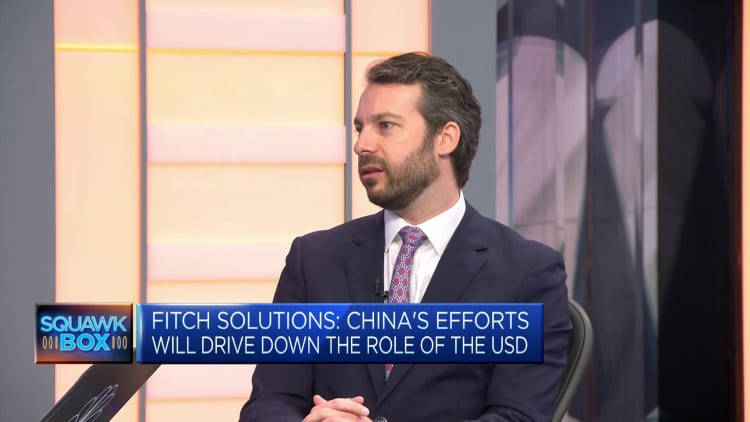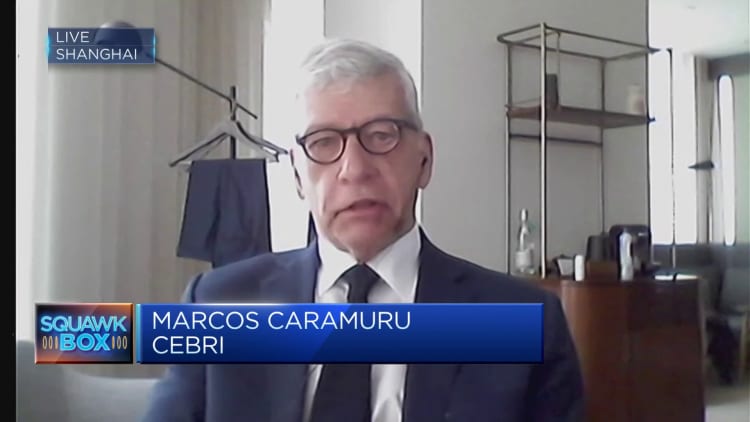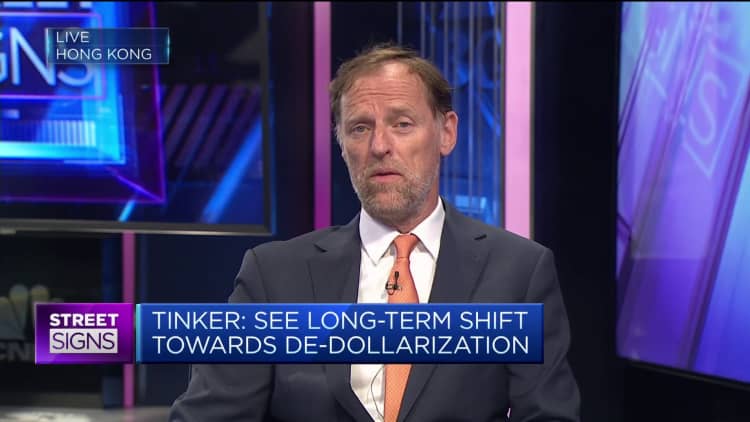[ad_1]
Calls to move away from relying on the U.S. dollar for trade are growing.
More and more countries — from Brazil to Southeast Asian nations — are calling for trade to be carried out in other currencies besides the U.S. dollar.
The U.S. dollar has been king in global trade for decades — not just because the U.S. is the world’s largest economy, but also because oil, a key commodity needed by all economies big and small, is priced in the greenback. Most commodities are also priced and traded in U.S. dollars.
But since the Federal Reserve embarked on a journey of aggressive rate hikes to fight domestic inflation, many central banks around the world have raised interest rates to stem capital outflows and a sharp depreciation of their own currencies.
“By diversifying their holdings reserves into a more multi-currency sort of portfolio, perhaps they can reduce that pressure on their external sectors,” said Cedric Chehab from Fitch Solutions.
To be clear, the U.S. dollar remains dominant in global forex reserves even though its share in central banks’ foreign exchange reserves has dropped from more than 70% in 1999, IMF data shows.
The U.S. dollar accounted for 58.36% of global foreign exchange reserves in the fourth quarter last year, according to data from the IMF’s Currency Composition of Foreign Exchange Reserves (COFER). Comparatively, the euro is a distant second, accounting for about 20.5% of global forex reserves while the Chinese yuan accounted for just 2.7% in the same period.
China is one of the most active players in this push given its dominant position in global trade right now, and as the world’s second largest economy.
Based on CNBC’s calculation of IMF’s data on 2022 direction of trade, mainland China was the largest trading partner to 61 countries when combining both imports and exports. In comparison, the U.S. was the largest trading partner to 30 countries.
“As China’s economic might continues to rise, that means that it’ll exert more influence in global financial institutions and trade etc,” Chehab told CNBC last week.

China — long among the top 2 foreign holders of U.S. Treasurys — has been steadily reducing its holdings of U.S. Treasury securities.
Mainland China held nearly $849 billion of U.S. Treasurys as of February this year, the latest data from the U.S. Treasury department showed. That’s at a 12-year low, according to historic data.
Changing dynamics

Economic benefits
Analysts say changing global economic dynamics are driving the co-called de-dollarization trend which can benefit local economies in a number of ways.
Trading in local currencies “allow exporters and importers to balance risks, have more options to invest, to have more certainty about the revenues and sales,” former Brazilian ambassador to China, Marcos Caramuru, told CNBC last week.
Another benefit for countries moving away from using the dollar as the middle man in bilateral trade, is to “help them move up the value chain,” said Mark Tinker from ToscaFund Hong Kong told CNBC “Street Signs Asia” early April.
“It isn’t about selling cheap stuff to Walmart, keeping down the prices for American consumers in order to earn dollars to buy its energy. This is now about actually a completely bilateral trade bloc,” Tinker said.

Meanwhile, growth of non-U.S. economic blocs also encourage these economies to push for wider use of their currencies. The IMF estimates that Asia could contribute more than 70% to global growth this year.
“U.S. growth might slow, but U.S. growth isn’t what it’s all about anymore. There is a whole non-U.S. block that’s growing,” said Tinker. “I think there is going to be a re-internationalization of flows.”
Geopolitical concerns
Geopolitical risks have also accelerated the trend to move away from U.S. dollar.
“Political risk is really helping introduce a lot of uncertainty and variability around how much of a safe haven that U.S. dollar really is,” said Galvin Chia from NatWest Markets told “Street Signs Asia” earlier.
Tinker said what accelerated the calls for de-dollarization was the U.S. decision to freeze Russia’s foreign currency reserves after Moscow invaded Ukraine in February 2022.
The yuan has reportedly replaced the U.S. dollar as the most traded currency in Russia, according to Bloomberg.
So far, the U.S. and its western allies have frozen more than $300 billion of Russia’s foreign currency reserves and slapped multiple rounds of sanctions on Moscow and the country’s oligarchs. This forced Russia to switch trade to other currencies and increase gold in its reserves.
“Now you find that if you disagree with U.S. foreign policy, you risk having those confiscated or frozen. You’ve got to have alternative place to put those assets,” Tinker said. In the Middle East, major oil exporter Saudi Arabia has reportedly signaled it’s open to trade in other currencies other than the greenback.
Although analysts don’t anticipate a complete break away from dollar-denominated oil trade over the short-term, “I think what they’re saying more is, well, there’s another player in town, and we want to look at how we trade with them on a bilateral basis using yuan,” said Chehab.
Dollar is still king
Despite the slow erosion of its hegemony, analysts say the U.S. dollar is not expected be dethroned in the near future — simply because there aren’t any alternatives right now.
“Euro is somewhat an imperfect fiscal and monetary union, the Japanese yen, which is another reserve currency, has all sorts of structural challenges in terms of the high debt loads,” Chehab told CNBC.
The Chinese yuan also falls short, Chehab said.
“If you look at the yuan reserves as a share of total reserves, it’s only about 2.5% of total reserves, and China still has current account restrictions,” Chehab said. “That means that it’s going to take a long time for any other currency, any single currency to really usurp the dollar from that perspective.”
Data from IMF shows that as of the fourth quarter of 2022, more than 58% of global reserves are held in U.S. dollar — that’s more than double the share of the euro, the second most-held currency in the world.
The international reserve system “is still a U.S.-reserve dominated system,” said NatWest’s Chia.
“So long as that commands the majority, so long as you don’t have another currency system or economy that’s willing to step up to that international reach, convertibility and free floating and the responsibility of a reserve currency, it’s hard to say dollar will be displaced over the next 3 to 5 years. unless someone steps up.”
— CNBC’s Joanna Tan and Monica Pitrelli contributed to this report.
[ad_2]

